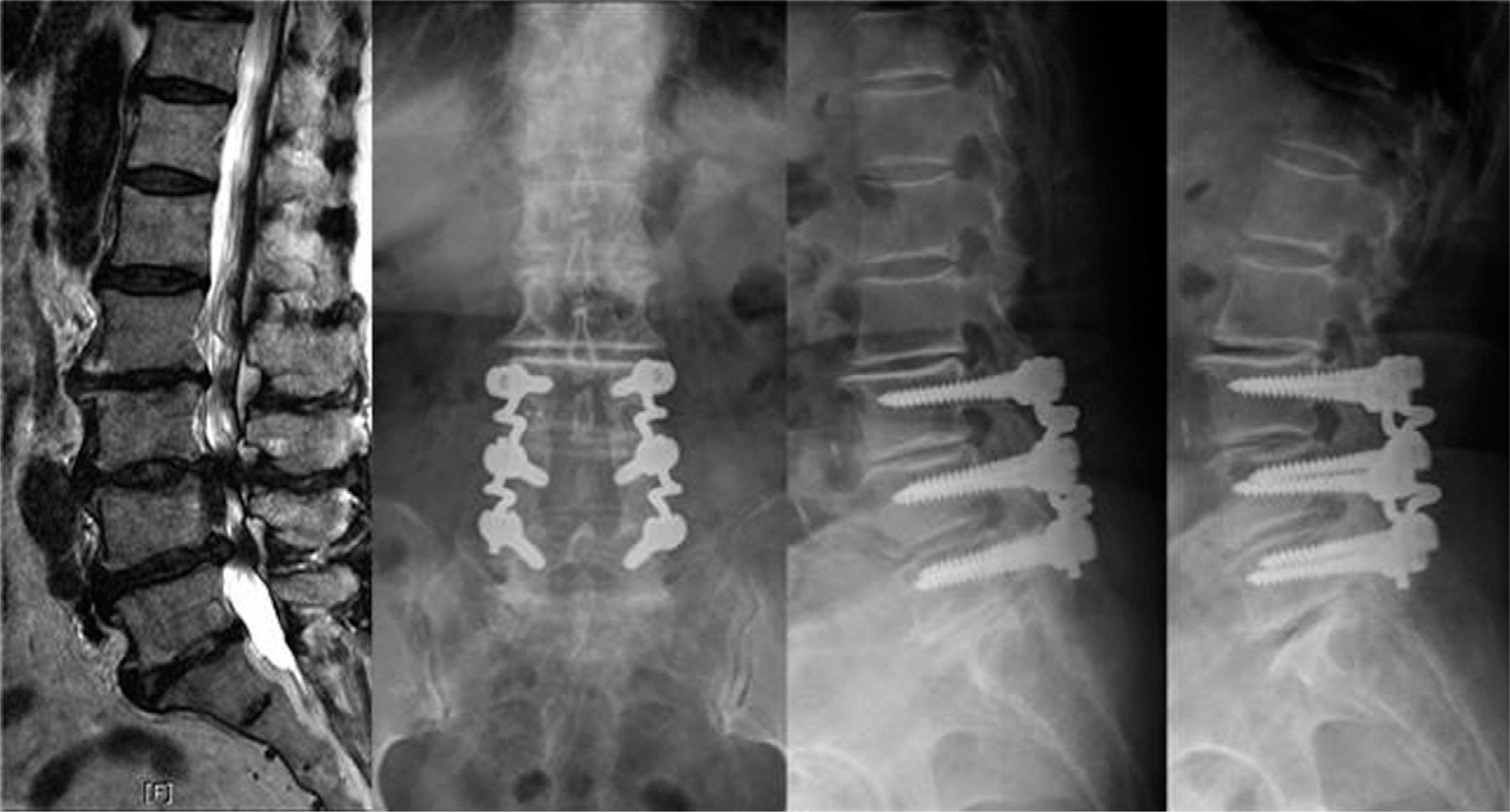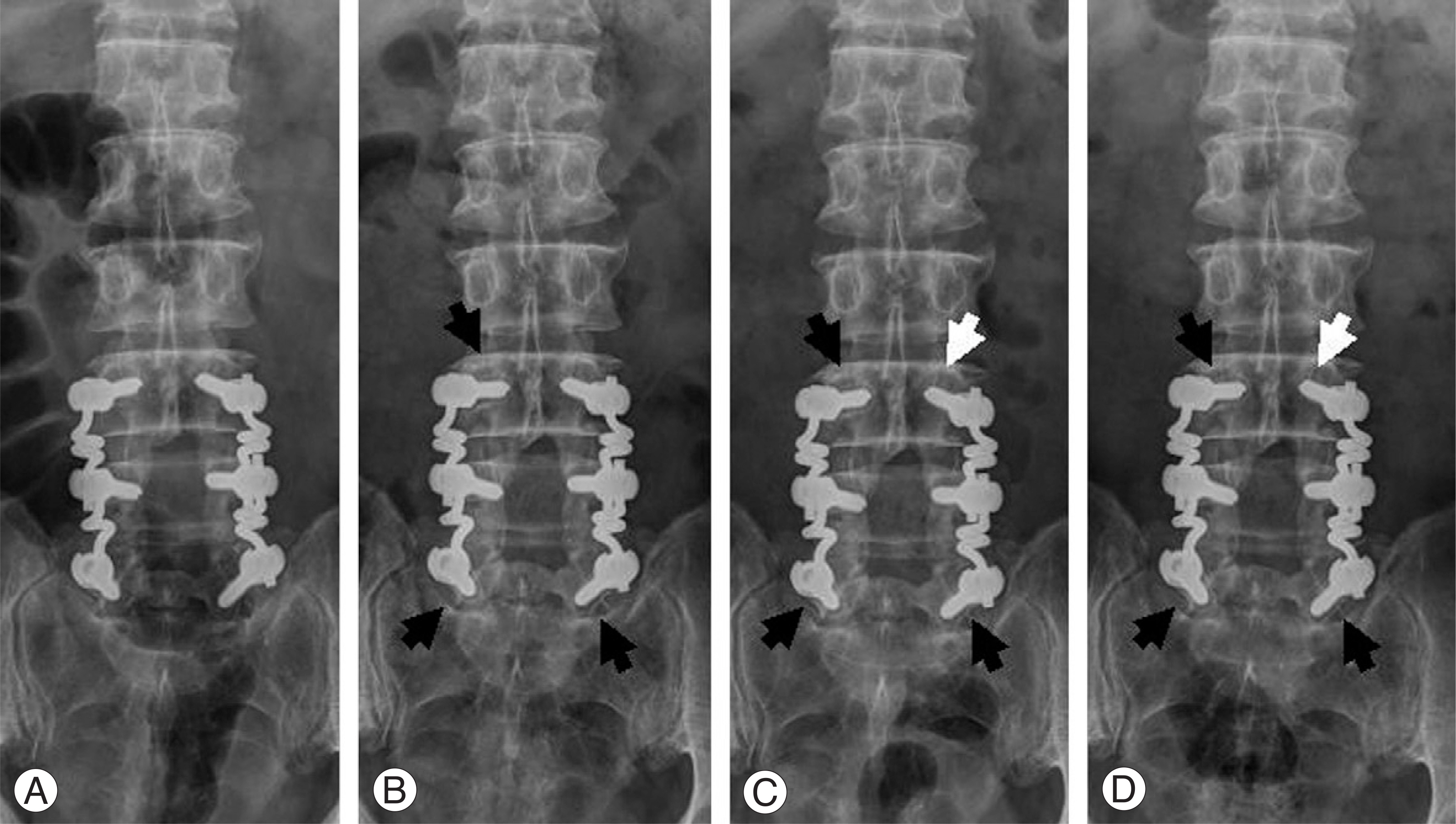J Korean Soc Spine Surg.
2009 Sep;16(3):194-201. 10.4184/jkss.2009.16.3.194.
Posterior Dynamic Stabilization with Selective Wide Decompression for Multilevel Lumbar Stenosis: Preliminary Result
- Affiliations
-
- 1Department of Orthopedic Surgery, School of Medicine, Kyung Hee University, Seoul, Korea. shl6@khu.ac.kr
- 2Department of Orthopedic Surgery, Hallym University, Chuncheon, Korea.
- KMID: 2003114
- DOI: http://doi.org/10.4184/jkss.2009.16.3.194
Abstract
- STUDY DESIGN: A prospective study
OBJECTIVES
We wanted to assess the clinical outcomes of posterior dynamic stabilization with selective wide decompression for treating multilevel lumbar stenosis in old age. SUMMARY OF THE LITERATURE REVIEW: Deciding on the segments to be operated on is challenging problem for old age patients with multilevel lumbar stenosis. There have been no reports on posterior dynamic stabilization with selective wide decompression for treating multilevel lumbar stenosis.
MATERIALS AND METHODS
We evaluated 18 patients who underwent posterior dynamic stabilization with selective decompression for multilevel disc degeneration and spinal stenosis. The mean age was 70.2 years and mean follow-up was 15.1 months. We evaluated the segmental angle, the range of motion (ROM) and pedicle screw loosening. The clinical results were evaluated according to the operative time, blood loss, the visual analogue scale (VAS) for the back pain and leg pain and and the Oswestry disability index (ODI).
RESULTS
The mean number of operated segments was 2.16. The lordosis of the lumbar and operated segments showed no significant difference. However, the ROM of the total lumbar spine and the operation segment was significantly decreased from 36.8 to 24.3 and 22.9 to 13.1, respectively. The ROM for the adjacent segment did not show a significant difference. A radiolucent line around the pedicle screw appeared at 22 screws (19.3%) out of a total 114 screws. The VAS for back and leg pain were improved from 7.5 and 8.6 to 2.3 and 2.1, respectively. The ODI was improved from 41.5 to 13.4.
CONCLUSIONS
The initial clinical outcomes were favorable after posterior dynamic stabilization with selective decompression. This procedure could be considered to be a useful option for treating multilevel stenosis in old age patients.
MeSH Terms
Figure
Reference
-
1). Cakir B, Richter M, Huch K, Puhl W, Schmidt R. Dynamic stabilization of the lumbar spine. Orthopedics. 2006; 29:716–722.
Article2). Grob D, Benini A, Junge A, Mannion AF. Clinical experience with the Dynesys semirigid fixation system for the lumbar spine: surgical and patient-oriented outcome in 50 cases after an average of 2 years. Spine. 2005; 30:324–331.3). Nockels RP. Dynamic stabilization in the surgical management of painful lumbar spinal disorders. Spine. 2005; 30:68–72.
Article4). Sapkas GS, Themistocleous GS, Mavrogenis AF, Bene-tos IS, Metaxas N, Papagelopoulos PJ. Stabilization of the lumbar spine using the dynamic neutralization system. Orthopedics. 2007; 30:859–865.
Article5). Schnake KJ, Schaeren S, Jeanneret B. Dynamic stabilization in addition to decompression for lumbar spinal stenosis with degenerative spondylolisthesis. Spine. 2006; 31:442–449.
Article6). Sengupta DK, Mulholland RC. Fulcrum assisted soft stabilization system: a new concept in the surgical treatment of degenerative low back pain. Spine. 2005; 30:1019–1029.7). Stoll TM, Dubois G, Schwarzenbach O. The dynamic neutralization system for the spine: a multicenter study of a novel non-fusion system. Eur Spine J. 2002; 11:170–178.
Article8). Pfirrmann CW, Metzdorf A, Zanetti M, Hodler J, Boos N. Magnetic resonance classification of lumbar intervertebral disc degeneration. Spine. 2001; 26:1873–1878.
Article9). Khoueir P, Kim KA, Wang MY. Classification of posterior dynamic stabilization devices. Neurosurg Focus. 2007; 22:3.
Article10). Rohlmann A, Burra NK, Zander T, Bergmann G. Comparison of the effects of bilateral posterior dynamic and rigid fixation devices on the loads in the lumbar spine: a finite element analysis. Eur Spine J. 2007; 16:1223–1231.
Article11). Scott-Young M. Posterior dynamic stabilization devices in the coming age of lumbar disc replacement. Neurosurg Focus. 2007; 22:14.12). Serhan HA, Varnavas G, Dooris AP, Patwadhan A, Tzermiadianos M. Biomechanics of the posterior lumbar articulating elements. Neurosurg Focus. 2007; 22:1.
Article13). Yue JJ, Timm JP, Panjabi MM, Jaramillo-De La Torre J. Clinical application of the Panjabi neutral zone hypoth- esis: the Stabilimax NZ posterior lumbar dynamic stabilization system. Neurosurg Focus. 2007; 22:12.14). Mulholland RC, Sengupta DK. Rationale, principles and experimental evaluation of the concept of soft stabilization. Eur Spine J. 2002; 11:198–205.
Article15). Sengupta DK. Dynamic stabilization devices in the treatment of low back pain. Neurology India. 2005; 53:466–468.
Article16). Beastall J, Karadimas E, Siddiqui M, et al. .:. The Dynesys lumbar spinal stabilization system: a preliminary report on positional magnetic resonance imaging findings. Spine. 2007; 32:685–690.17). Highsmith JM, Tumialan LM, Rodts GE Jr. .:. Flexible rods and the case for dynamic stabilization. Neurosurg Focus. 2007; 22:11.
Article18). Schmoelz W, Huber JF, Nydegger T, Dipl-Ing , Claes L, Wilke HJ. Dynamic stabilization of the lumbar spine and its effects on adjacent segments: an in vitro experiment. Journal of Spinal Disorders & Techniques. 2003; 16:418–423.19). Bellini CM, Galbusera F, Raimondi MT, Mineo GV, Brayda-Bruno M. Biomechanics of the lumbar spine after dynamic stabilization. J Spinal Disord Tech. 2007; 20:423–429.
Article20). Korovessis P, Papazisis Z, Koureas G, Lambiris E. Rigid, semirigid versus dynamic instrumentation for degenerative lumbar spinal stenosis: a correlative radiological and clinical analysis of short-term results. Spine. 2004; 29:735–742.21). Niosi CA, Zhu QA, Wilson DC, Keynan O, Wilson DR, Oxland TR. Biomechanical characterization of the three-dimensional kinematic behavior of the Dynesys dynamic stabilization system: an in vitro study. Eur Spine J. 2006; 15:913–922.22). Kanayama M, Hashimoto T, Shigenobu K, Togawa D, Oha F. A minimum 10-year followup of posterior dynamic stabilization using graft artificial ligament. Spine. 2007; 32:1992–1996.23). Welch WC, Cheng BC, Awad TE, et al. .:. Clinical outcomes of the Dynesys dynamic neutralization system: 1-year preliminary results. Neurosurg Focus. 2007; 22:8.
Article24). Mandingo CE, Sampath P, Kaiser MG. Posterior dynamic stabilization of the lumbar spine: pedicle based stabilization with the AccuFlex rod system. Neurosurg Focus. 2007; 22:9.25). Betz RR, Kim J, D'Andrea LP, et al. .:. An innovative technique of vertebral body stapling for the treatment of patients with adolescent idiopathic scoliosis: A feasibility, safety, and utility study. Spine. 2003; 28:255–265.
Article26). Kim YS, Zhang HY, Moon BJ, et al. .:. Nitinol spring rod dynamic stabilization system and Nitinol memory loops in surgical treatment for lumbar disc disorders: short-term follow up. Neurosurg Focus. 2007; 22:10.
Article27). Rhalmi S, Charette S, Assad M, Coillard C, Rivard CH. The spinal cord dura mater reaction to Nitinol and titanium particles: a 1-year study in rabbits. Eur Spine J. 2007; 16:1063–1072.
- Full Text Links
- Actions
-
Cited
- CITED
-
- Close
- Share
- Similar articles
-
- Posterior Decompression and Fusion in Patients with Multilevel Lumbar Foraminal Stenosis: A Comparison of Segmental Decompression and Wide Decompression
- Late Complications of the Single Level 'Interspinous U' in Lumbar Spinal Stenosis with Mild Segmental Instability
- Cotrel - Dubousset Pedicle Screw Fixation After Posterior Decompression of Lumbar Spinal Stenosis
- Oblique Lumbar Interbody Fusion with Selective Biportal Endoscopic Posterior Decompression for Multilevel Lumbar Degenerative Diseases
- The Incidence of Adjacent Segment Degeneration after the Use of a Versatile Dynamic Hybrid Stabilization Device in Lumbar Stenosis: Results of a 5–8-Year Follow-up



